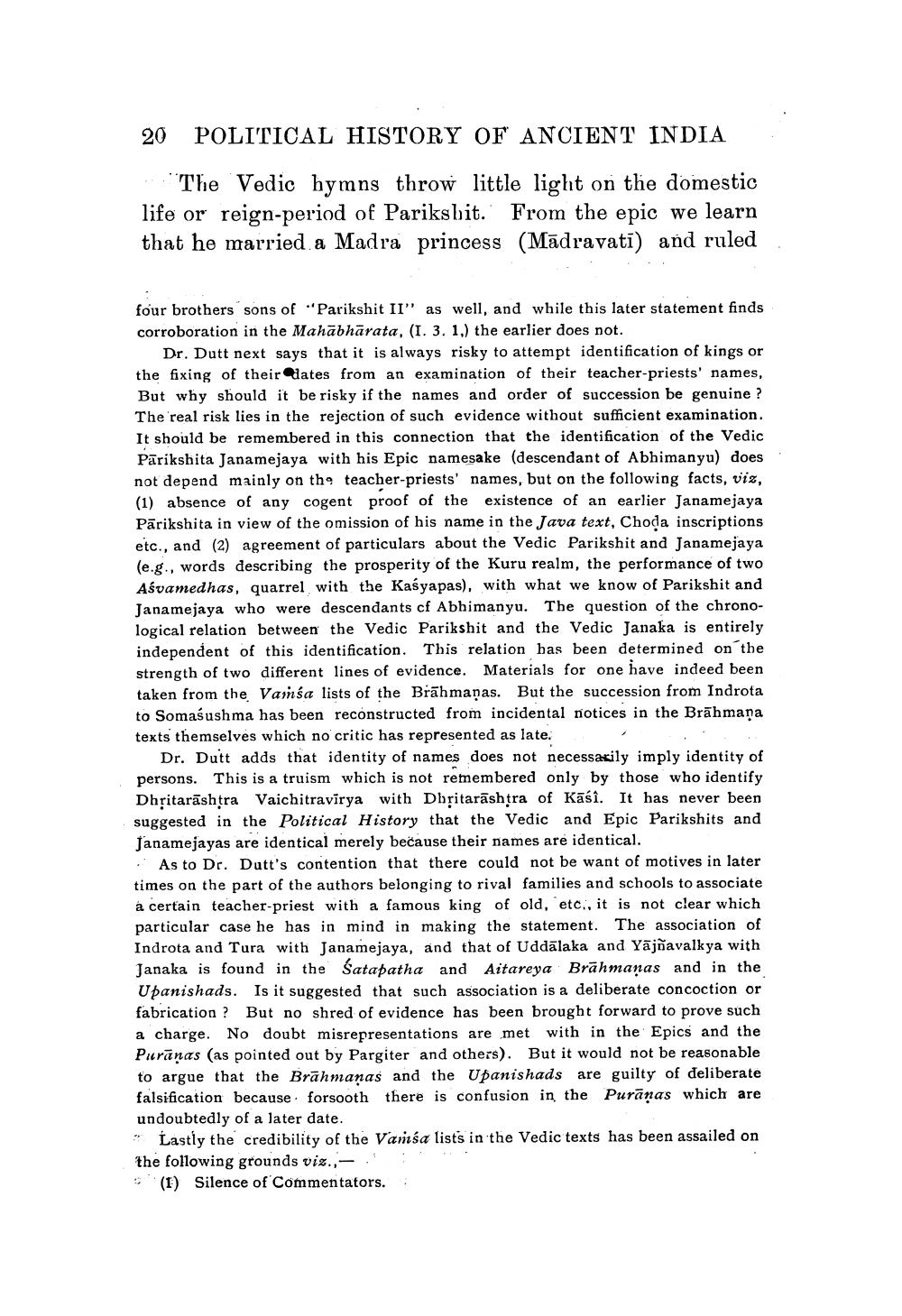________________
20 POLITICAL HISTORY OF ANCIENT INDIA
The Vedic hymns throw little light on the domestic life or reign-period of Pariksbit. From the epic we learn that he married a Madra princess (Mādravatī) and ruled
four brothers sons of "Parikshit II" as well, and while this later statement finds corroboration in the Mahābhārata, (I. 3. 1,) the earlier does not.
Dr. Dutt next says that it is always risky to attempt identification of kings or the fixing of their dates from an examination of their teacher-priests' names, But why should it be risky if the names and order of succession be genuine ? The 'real risk lies in the rejection of such evidence without sufficient examination. It should be remembered in this connection that the identification of the Vedic Pārikshita Janamejaya with his Epic namesake (descendant of Abhimanyu) does not depend mainly on the teacher-priests' names, but on the following facts, viz, (1) absence of any cogent proof of the existence of an earlier Janamejaya Pārikshita in view of the omission of his name in the Java text, Choda inscriptions etc., and (2) agreement of particulars about the Vedic Parikshit and Janamejaya (e.g., words describing the prosperity of the Kuru realm, the performance of two Aśvamedhas, quarrel with the Kasyapas), with what we know of Parikshit and Janamejaya who were descendants cf Abhimanyu. The question of the chronological relation between the Vedic Parikshit and the Vedic Janaka is entirely independent of this identification. This relation has been determined on the strength of two different lines of evidence. Materials for one have indeed been taken from the Vamsa lists of the Brāhmaṇas. But the succession from Indrota to Somaśushma has been reconstructed from incidental notices in the Brāhmaṇa texts themselves which no critic has represented as late.
Dr. Dutt adds that identity of names does not necessarily imply identity of persons. This is a truism which is not remembered only by those who identify Dhțitarāshtra Vaichitravīrya with Dhritarāshtra of Kāśi. It has never been suggested in the Political History that the Vedic and Epic Parikshits and Janamejayas are identical merely because their names are identical. . As to Dr. Dutt's contention that there could not be want of motives in later times on the part of the authors belonging to rival families and schools to associate á certain teacher-priest with a famous king of old, etc., it is not clear which particular case he has in mind in making the statement. The association of Indrota and Tura with Janamejaya, and that of Uddālaka and Yājñavalkya with Janaka is found in the Satapatha and Aitareya Brāhmanas and in the Upanishads. Is it suggested that such association is a deliberate concoction or fabrication ? But no shred of evidence has been brought forward to prove such a charge. No doubt misrepresentations are met with in the Epics and the Purānas (as pointed out by Pargiter and others). But it would not be reasonable to argue that the Brāhmanas and the Upanishads are guilty of deliberate falsification because forsooth there is confusion in the Purānas which are undoubtedly of a later date.
Lastly the credibility of the Vansa lists in the Vedic texts has been assailed on the following grounds viz.,-. :
(1) Silence of Commentators.




